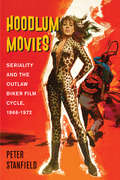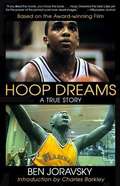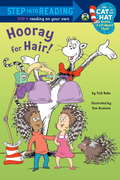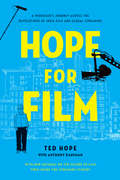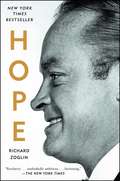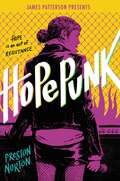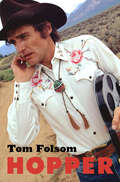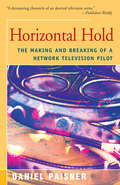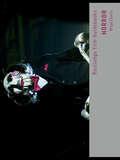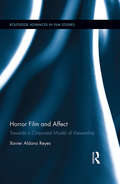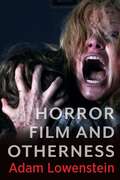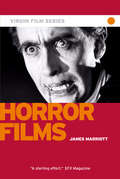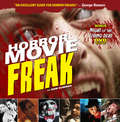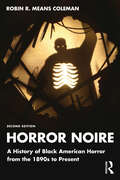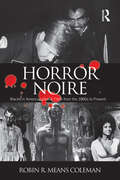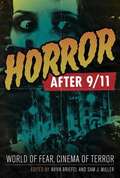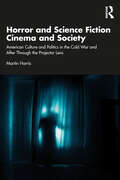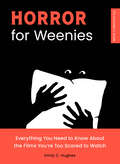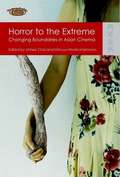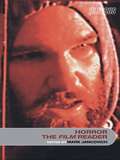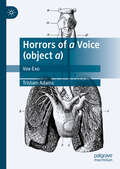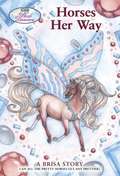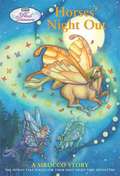- Table View
- List View
Hoodlum Movies: Seriality and the Outlaw Biker Film Cycle, 1966-1972
by Peter StanfieldFrom The Wild Angels in 1966 until its conclusion in 1972, the cycle of outlaw motorcycle films contained forty-odd formulaic examples. All but one were made by independent companies that specialized in producing exploitation movies for drive-ins, neighborhood theaters, and rundown inner city theaters. <P><P>Despised by critics, but welcomed by exhibitors denied first-run films, these cheaply and quickly produced movies were made to appeal to audiences of mobile youths. The films are repetitive, formulaic, and eminently forgettable, but there is a story to tell about all of the above, and it is one worth hearing. <P><P>Hoodlum Movies is not only about the films, its focus is on why and how these films were made, who they were made for, and how the cycle developed through the second half of the 1960s and came to a shuddering halt in 1972.
Hoop Dreams: A True Story of Hardship and Triumph
by Ben JoravskyAward-winning journalist Ben Joravsky vividly brings to life all the richness and subtlety of the experiences of Arthur Agee and William Gates, two gifted urban hoopsters determined to make it to the NBA, in this intimate, suspenseful, and heart-wrenching adaptation of the award-winning film documentary.
Hooray for Hair! (Step into Reading)
by Tom Brannon Tish RabeThe Cat in the Hat goes on a hairy adventure in this leveled reader for independent readers all about--what else?--hair! It's Crazy Hair Day at Sally and Nick's school, and the kids can't pick a style to wear. Curly or straight? Long or short? It's too hard to choose--until the Cat in the Hat arrives with his Wig-o-lator--a machine that allows the kids to "try on" the hairstyles of a yak, a fur seal, and a porcupine, with comical (and educational) results! Written specifically for children learning to read on their own, this Step 3 book is based on an episode of the hit PBS Kids' TV show The Cat in the Hat Knows a Lot About That! Young readers will flip their wigs over it!
Hope for Film: From the Frontline of the Independent Cinema Revolutions
by Ted HopeAn inspiring, tell-all look at the indie film business from one of the industry's most passionate producers, Hope for Film captures the rebellious punk spirit of the indie film boom in 1990s New York City, its collapse two decades later and its current moment of technology-fueled regeneration. Ted Hope, whose films have garnered 12 Oscar nominations, draws from his own personal experiences working on the early films of Ang Lee, Eddie Burns, Hal Hartley, Michel Gondry, Nicole Holofcener, Todd Solondz and other indie mavericks, relating those decisions that brought him success as well as the occasional failure.Whether navigating negotiations with Harvey Weinstein over final cuts or clashing with high-powered CAA agents over their clients, Hope offers behind-the-scenes stories from the wild and often heated world of low-budget cinema-where art and commerce collide. As mediator between these two opposing interests, Hope offers his unique perspective on how to make movies while keeping your integrity intact and how to create a sustainable business enterprise out of that art while staying true to yourself. Against a backdrop of seismic changes in the indie-film industry, from corporate co-option to the rise of social media, Hope for Film provides not only an entertaining and intimate ride through the ups and downs of the business of art-house movies over the last 25 years, but also hope for its future.
Hope: Entertainer of the Century
by Richard ZoglinThe first definitive biography of Bob Hope, featuring exclusive and extensive reporting that makes the persuasive case that he was most important entertainer of the twentieth century.Born in 1903, and until his death in 2003, Bob Hope was the only entertainer to achieve top-rated success in every major mass-entertainment medium, from vaudeville to television and everything in between. He virtually invented modern stand-up comedy. His tours to entertain US troops and patriotic radio broadcasts, along with his all-American, brash-but-cowardly movie character, helped to ease the nation's jitters during the stressful days of World War II. He helped redefine the very notion of what it means to be a star: a savvy businessman, pioneer of the brand extension (churning out books, writing a newspaper column, hosting a golf tournament), and public-spirited entertainer whose Christmas military tours and tireless work for charity set the standard for public service in Hollywood. But he became a polarizing figure during the Vietnam War, and the book sheds new light on his close relationship with President Richard Nixon during those embattled years. Bob Hope is a household name. However, as Richard Zoglin shows in this revelatory biography, there is still much to be learned about this most public of figures, from his secret first marriage and his stint in reform school, to his indiscriminate womanizing and his ambivalent relationship with Bing Crosby and Johnny Carson. Hope could be cold, self-centered, tight with a buck, and perhaps the least introspective man in Hollywood. But he was also a dogged worker, gracious with fans, and generous with friends. Hope is both a celebration of an entertainer whose vast contribution has never been properly appreciated, and a complex portrait of a gifted but flawed man, who, unlike many Hollywood stars, truly loved being famous, appreciated its responsibilities, and handled celebrity with extraordinary grace.
Hopepunk
by Preston NortonFollowing the disappearance of her sister, Hope Cassidy rebels against a life that once controlled her, as she learns about forgiveness and redemption—and how hope is the ultimate act of rebellion—in this heartfelt and funny novel. Growing up in a conservative Christian household isn&’t easy for rock-obsessed Hope Cassidy. She's spent her whole life being told that the devil speaks through Led Zeppelin, but it&’s even worse for her sister, Faith, who feels like she can&’t be honest about dating the record shop cashier, Mavis. That is, until their youngest sister hears word of their "sinful" utopia and outs Faith to their parents. Now there&’s nowhere for Faith to go but the Change Through Grace conversion center…or running away. Following Faith&’s disappearance, their family is suddenly broken. Hope feels a need to rebel. She gets a tattoo and tries singing through the hurt with her Janis Joplin-style voice. But when her long-time crush Danny comes out and is subsequently kicked out of his house, Hope can&’t stand by and let history repeat itself. Now living in Faith&’s room, Danny and Hope strike up a friendship...and a band. And their music just might be the answer to dethroning Alt-Rite, Danny&’s twin brother's new hate-fueled band. With a hilarious voice and an open heart, Hopepunk is a novel about forgiveness, redemption, and finding your home, and about how hope is the ultimate act of rebellion.
Hopper
by Tom FolsomJames Dean to Hopper "I saw what you did today. Today you were great. " Jack Nicholson to Hopper "We're geniuses, you know that? Isn't it great to be a genius?" The chopper-riding hippie outlaw in Easy Rider. The prophetic madman in the jungle in Apocalypse Now. The terrifying psychopath in Blue Velvet. The kid gone wrong in Rebel Without a Cause. The actor taken under the wing of James Dean who longed to be the next Orson Welles. The hell-raising director who revolutionized Hollywood. An enigmatic man from Dodge City, Kansas, on an endless quest to realize the American Dream. Dennis Hopper has been described as a rebel, an icon, an addict plagued by demons, and one of the most important champions of the pop-art movement. Friend to Warhol, muse to David Lynch, mentor to Sean Penn, champion of Ice-T, Dennis Hopper built a career that was a half-century of rebellion waged at the edge of American popular culture. Tom Folsom's Hopper is a wild ride through Dennis's many lives. Featuring hundreds of interviews with Hopper's fellow actors, artists, musicians, and residents of Taos, New Mexico (where he spent much of his most manic time), as well as his ex-wives and many other people who knew him, Hopper takes you on an extraordinary-and sometimes troubling-journey. From Dennis's early days with his grandparents on a dusty farm in Kansas, where he watched trains go by on their way to Los Angeles, to his formative time in Hollywood as one of a bright new crop of actors straddling the edge of the studio system, to the rebellious 1960s and the start of the independent film movement, to the drug-addled 1970s and beyond, when Hopper staged one of the greatest Hollywood comebacks of all time-Tom Folsom has crafted a biography as unconventional as Dennis Hopper himself.
Horizontal Hold: The Making and Breaking of a Network Television Pilot
by Daniel PaisnerAbsurdly funny, trenchant, and provocative, this outside-looking-in account of the stillbirth of one particular television series is a must read for every serious and not-so-serious television viewer.
Hornblower's Ships: Their History and Their Models
by Martin SavilleHornblower stories was one of the most expensive series ever made for television. Millions went into the lavish special effects to recreate the epic sea battles featuring eleven fully working scale models.
Horowitz: A Biography of Vladimir Horowitz
by Glenn PlaskinWell-researched, richly evocative and provocative biography of the legendary Russian pianist.
Horror (Routledge Film Guidebooks)
by Brigid CherryHorror cinema is a hugely successful, but at the same time culturally illicit genre that spans the history of cinema. It continues to flourish with recent cycles of supernatural horror and torture porn that span the full range of horror styles and aesthetics. It is enjoyed by audiences everywhere, but also seen as a malign influence by others. In this Routledge Film Guidebook, audience researcher and film scholar Brigid Cherry provides a comprehensive overview of the horror film and explores how the genre works. Examining the way horror films create images of gore and the uncanny through film technology and effects, Cherry provides an account of the way cinematic and stylistic devices create responses of terror and disgust in the viewer. Horror examines the way these films construct psychological and cognitive responses and how they speak to audiences on an intimate personal level, addressing their innermost fears and desires. Cherry further explores the role of horror cinema in society and culture, looking at how it represents various identity groups and engages with social anxieties, and examining the way horror sees, and is seen by, society.
Horror Film and Affect: Towards a Corporeal Model of Viewership (Routledge Advances in Film Studies)
by Xavier Aldana ReyesThis book brings together various theoretical approaches to Horror that have received consistent academic attention since the 1990s – abjection, disgust, cognition, phenomenology, pain studies – to make a significant contribution to the study of fictional moving images of mutilation and the ways in which human bodies are affected by those on the screen on three levels: representationally, emotionally and somatically. Aldana Reyes reads Horror viewership as eminently carnal, and seeks to articulate the need for an alternative model that understands the experience of feeling under corporeal threat as the genre’s main descriptor. Using recent, post-millennial examples throughout, the book also offers case studies of key films such as Hostel, [REC], Martyrs or Ginger Snaps, and considers contemporary Horror strands such as found footage or 3D Horror.
Horror Film and Otherness (Film and Culture Series)
by Adam LowensteinWhat do horror films reveal about social difference in the everyday world? Criticism of the genre often relies on a dichotomy between monstrosity and normality, in which unearthly creatures and deranged killers are metaphors for society’s fear of the “others” that threaten the “normal.” The monstrous other might represent women, Jews, or Blacks, as well as Indigenous, queer, poor, elderly, or disabled people. The horror film’s depiction of such minorities can be sympathetic to their exclusion or complicit in their oppression, but ultimately, these images are understood to stand in for the others that the majority dreads and marginalizes.Adam Lowenstein offers a new account of horror and why it matters for understanding social otherness. He argues that horror films reveal how the category of the other is not fixed. Instead, the genre captures ongoing metamorphoses across “normal” self and “monstrous” other. This “transformative otherness” confronts viewers with the other’s experience—and challenges us to recognize that we are all vulnerable to becoming or being seen as the other. Instead of settling into comforting certainties regarding monstrosity and normality, horror exposes the ongoing struggle to acknowledge self and other as fundamentally intertwined.Horror Film and Otherness features new interpretations of landmark films by directors including Tobe Hooper, George A. Romero, John Carpenter, David Cronenberg, Stephanie Rothman, Jennifer Kent, Marina de Van, and Jordan Peele. Through close analysis of their engagement with different forms of otherness, this book provides new perspectives on horror’s significance for culture, politics, and art.
Horror Films - Virgin Film
by James MarriottFrom the Slick horror of Alien, Scream and The Ring and the cult classics Dracula, Frankenstein and The Mummy to the slasher icons Jason, Freddy and Leatherface, horror just won’t stay dead. The genre has earned its place in the moviegoing psyche, with many of the key films spawning numerous copycats. But what are the 20 most influential horror films of all time? And what made them so important?James Marriott give an incisive account of the definitive works (and the most influential directors) of the genre over the last 80 years – from silent Expressionist classics to Japanese wraiths. The book reveals the inspiration behind each film and examines the choice of director, cast, soundtrack and marketing. Marriott analyzes the critical reception of each film and examines the subsequent impact on the industry and the public worldwide.
Horror Movie Freak
by Don SumnerYou'll scream with delight while reading this fun and engaging book that discusses fright flicks all horror fans need to see to ascend to the level of a true Horror Freak -from classics (Dracula and Psycho) to modern movies (Drag Me to Hell) and lesser-known gems (Dog Soldiers). Movies are divided into various categories including Asian horror, beginners, homicidal slashers, supernatural thrillers, and zombie invasion. Features more than 130 movies, 250+ photos of movie stills and posters, and a chapter on remakes and reimaginings. The book also includes the DVD of George A. Romero's original 1968 version of "Night of the Living Dead."
Horror Noire: A History of Black American Horror from the 1890s to Present
by Robin R. Means ColemanFrom King Kong to Candyman, the boundary-pushing genre of horror film has always been a site for provocative explorations of race in American popular culture. This book offers a comprehensive chronological survey of Black horror from the 1890s to present day. In this second edition, Robin R. Means Coleman expands upon the history of notable characterizations of Blackness in horror cinema, with new chapters spanning the 1960s, 2000s, and 2010s to the present, and examines key levels of Black participation on screen and behind the camera. The book addresses a full range of Black horror films, including mainstream Hollywood fare, art-house films, Blaxploitation films, and U.S. hip-hop culture-inspired Nollywood films. This new edition also explores the resurgence of the Black horror genre in the last decade, examining the success of Jordan Peele’s films Get Out (2017) and Us (2019), smaller independent films such as The House Invictus (2018), and Nia DaCosta’s sequel to Candyman (2021). Means Coleman argues that horror offers a unique representational space for Black people to challenge negative or racist portrayals, and to portray greater diversity within the concept of Blackness itself. This book is essential reading for anyone seeking to understand how fears and anxieties about race and race relations are made manifest, and often challenged, on the silver screen.
Horror Noire: Blacks in American Horror Films from the 1890s to Present
by Robin R Means ColemanFrom King Kong to Candyman, the boundary-pushing genre of the horror film has always been a site for provocative explorations of race in American popular culture. In Horror Noire: Blacks in American Horror Films from 1890's to Present, Robin R. Means Coleman traces the history of notable characterizations of blackness in horror cinema, and examines key levels of black participation on screen and behind the camera. She argues that horror offers a representational space for black people to challenge the more negative, or racist, images seen in other media outlets, and to portray greater diversity within the concept of blackness itself. Horror Noire presents a unique social history of blacks in America through changing images in horror films. Throughout the text, the reader is encouraged to unpack the genre’s racialized imagery, as well as the narratives that make up popular culture’s commentary on race. Offering a comprehensive chronological survey of the genre, this book addresses a full range of black horror films, including mainstream Hollywood fare, as well as art-house films, Blaxploitation films, direct-to-DVD films, and the emerging U.S./hip-hop culture-inspired Nigerian "Nollywood" Black horror films. Horror Noire is, thus, essential reading for anyone seeking to understand how fears and anxieties about race and race relations are made manifest, and often challenged, on the silver screen.
Horror after 9/11
by Aviva Briefel Sam J. MillerHorror films have exploded in popularity since the tragic events of September 11, 2001, many of them breaking box-office records and generating broad public discourse. These films have attracted A-list talent and earned award nods, while at the same time becoming darker, more disturbing, and increasingly apocalyptic. Why has horror suddenly become more popular, and what does this say about us? What do specific horror films and trends convey about American society in the wake of events so horrific that many pundits initially predicted the death of the genre? How could American audiences, after tasting real horror, want to consume images of violence on screen? Horror after 9/11 represents the first major exploration of the horror genre through the lens of 9/11 and the subsequent transformation of American and global society. Films discussed include the Twilight saga; the Saw series; Hostel; Cloverfield; 28 Days Later; remakes of The Texas Chainsaw Massacre, Dawn of the Dead, and The Hills Have Eyes; and many more. The contributors analyze recent trends in the horror genre, including the rise of ‘torture porn,’ the big-budget remakes of classic horror films, the reinvention of traditional monsters such as vampires and zombies, and a new awareness of visual technologies as sites of horror in themselves. The essays examine the allegorical role that the horror film has held in the last ten years, and the ways that it has been translating and reinterpreting the discourses and images of terror into its own cinematic language.
Horror and Science Fiction Cinema and Society: American Culture and Politics in the Cold War and After Through the Projector Lens
by Martin HarrisExamining how horror and science fiction films from the 1950s to the present invent and explore fictional “us-versus-them” scenarios, this book analyzes the different ways such films employ allegory and/or satire to interrogate the causes and consequences of increasing polarization in American politics and society.Starting with the killer ants film with an anti-communist subtext Them! (1954) and concluding with Jordan Peele’s social horror film with revenge-seeking homicidal doppelgängers Us (2019), Martin Harris highlights social and political contexts, contemporary reviews and responses, and retrospective evaluations to show how American horror and science fiction films reflect and respond to contemporary conflicts marking various periods in U.S. history from post-WWII to the present, including those concerning race, gender, class, faith, political ideology, national identity, and other elements of American society.Horror and Science Fiction Cinema and Society draws upon cinematic sociology to provide a resourceful approach to American horror and science fiction films that integrates discussion of plot construction and character development with analyses of the thematic uses of conflict, guiding readers’ understanding of how filmmakers create otherworldly confrontations to deliver real-world social and political commentary.
Horror for Weenies: Everything You Need to Know About the Films You're Too Scared to Watch
by Emily C. HughesA smart, funny crash course in 25 iconic horror movies, from Psycho to Hereditary, for people who love getting the reference but hate being scared.You don't have to miss out just because you don't like to be frightened! Stop trying to read nonsensical Wikipedia plot summaries (we know you&’re doing it), and let an expert tell you everything you need to know about the most influential horror films of the past 60 years—without a single jump scare or a drop of gore.With a rundown of the history and significance of horror cinema, explanations of common tropes, and detailed entries on 25 important movies ranging from Night of the Living Dead to The Blair Witch Project to Get Out, Horror for Weenies will turn even the scarediest of cats into a confident connoisseur.Each entry includes: A detailed plot summary, with enough jokes that it won&’t freak you outSmart, illuminating analysis of the film&’s themes and cultural significance Descriptions of iconic scenes you definitely do not want to look at Talking points for impressing even the biggest scary-movie buffsHorror for Weenies is the first installment in the Outsider&’s Guide series, which offers highly readable crash courses in major cultural phenomena, so you can catch the references and understand the big deal. Never get left out of a conversation again!
Horror to the Extreme
by Jinhee Choi Mitsuyo Wada-MarcianoThis book compares production and consumption of Asian horror cinemas in different national contexts and their multidirectional dialogues with Hollywood and neighboring Asian cultures. Individual essays highlight common themes including technology, digital media, adolescent audience sensibilities, transnational co-productions, pan-Asian marketing techniques, and variations on good vs. evil evident in many Asian horror films. Contributors include Kevin Heffernan, Adam Knee, Chi-Yun Shin, Chika Kinoshita, Robert Cagle, Emilie Yeh Yueh-yu, Neda Ng Hei-tung, Hyun-suk Seo, Kyung Hyun Kim, and Robert Hyland.
Horror, The Film Reader (In Focus: Routledge Film Readers)
by Mark JancovichHorror, The Film Reader brings together key articles to provide a comprehensive resource for students of horror cinema. Mark Jancovich's introduction traces the development of horror film from The Cabinet of Dr. Caligari to The Blair Witch Project, and outlines the main critical debates. Combining classic and recent articles, each section explores a central issue of horror film, and features an editor's introduction outlining the context of debates.
Horrors of a Voice (object a): Vox-Exo
by Tristam AdamsThis book reframes the Lacanian object a voice as a horrific register of alterity. The object gaze has received, as it does in Jacques Lacan’s work, more commentary than voice. Yet recently voice has garnered interest from multiple disciplines. The book intervenes in the Slovenian school’s commentary of the ‘object voice’ in terms of two questions: audition and corporeality. This intervention synthesizes psychoanalysis with recent theorizing of the horror of philosophy. In this intervention the object a voice is argued to resonate in lacunae – epistemological voids that evoke horror in the subject. Biological and evolutionary perspectives on voice, genre horror film and literature, music videos, close readings of Freudian and Lacanian case studies and textual analysis of ancient philosophy texts all contribute to an elucidation of the horrors of the object a voice: Vox-Exo.
Horses Her Way (Wind Dancers, Book #6)
by Sibley MillerBeautiful Brisa, with her sunset-pink coat and blonde mane and tail, happily sets out to make the world--and everything in it, including her fellow Wind Dancers--as lovely as she is. Sounds like a plan--that only one horse can love!
Horses' Night Out (Wind Dancers, Book #4)
by Sibley MillerMeet the Wind Dancers® Four tiny horses with shiny manes and shimmering wings burst from a puff of dandelion seeds! Four magical horses who can fly. BOOK 4: Horses' Night Out What's it like to be out in the dark of night? The three magical fillies and the one colt, who is sure he's going to love the adventure, are about to find out.
